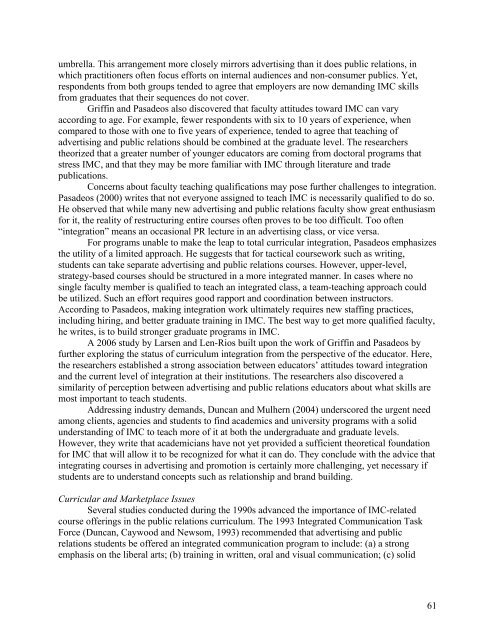2008 PROCEEDINGS - Public Relations Society of America
2008 PROCEEDINGS - Public Relations Society of America
2008 PROCEEDINGS - Public Relations Society of America
You also want an ePaper? Increase the reach of your titles
YUMPU automatically turns print PDFs into web optimized ePapers that Google loves.
umbrella. This arrangement more closely mirrors advertising than it does public relations, in<br />
which practitioners <strong>of</strong>ten focus efforts on internal audiences and non-consumer publics. Yet,<br />
respondents from both groups tended to agree that employers are now demanding IMC skills<br />
from graduates that their sequences do not cover.<br />
Griffin and Pasadeos also discovered that faculty attitudes toward IMC can vary<br />
according to age. For example, fewer respondents with six to 10 years <strong>of</strong> experience, when<br />
compared to those with one to five years <strong>of</strong> experience, tended to agree that teaching <strong>of</strong><br />
advertising and public relations should be combined at the graduate level. The researchers<br />
theorized that a greater number <strong>of</strong> younger educators are coming from doctoral programs that<br />
stress IMC, and that they may be more familiar with IMC through literature and trade<br />
publications.<br />
Concerns about faculty teaching qualifications may pose further challenges to integration.<br />
Pasadeos (2000) writes that not everyone assigned to teach IMC is necessarily qualified to do so.<br />
He observed that while many new advertising and public relations faculty show great enthusiasm<br />
for it, the reality <strong>of</strong> restructuring entire courses <strong>of</strong>ten proves to be too difficult. Too <strong>of</strong>ten<br />
“integration” means an occasional PR lecture in an advertising class, or vice versa.<br />
For programs unable to make the leap to total curricular integration, Pasadeos emphasizes<br />
the utility <strong>of</strong> a limited approach. He suggests that for tactical coursework such as writing,<br />
students can take separate advertising and public relations courses. However, upper-level,<br />
strategy-based courses should be structured in a more integrated manner. In cases where no<br />
single faculty member is qualified to teach an integrated class, a team-teaching approach could<br />
be utilized. Such an effort requires good rapport and coordination between instructors.<br />
According to Pasadeos, making integration work ultimately requires new staffing practices,<br />
including hiring, and better graduate training in IMC. The best way to get more qualified faculty,<br />
he writes, is to build stronger graduate programs in IMC.<br />
A 2006 study by Larsen and Len-Rios built upon the work <strong>of</strong> Griffin and Pasadeos by<br />
further exploring the status <strong>of</strong> curriculum integration from the perspective <strong>of</strong> the educator. Here,<br />
the researchers established a strong association between educators’ attitudes toward integration<br />
and the current level <strong>of</strong> integration at their institutions. The researchers also discovered a<br />
similarity <strong>of</strong> perception between advertising and public relations educators about what skills are<br />
most important to teach students.<br />
Addressing industry demands, Duncan and Mulhern (2004) underscored the urgent need<br />
among clients, agencies and students to find academics and university programs with a solid<br />
understanding <strong>of</strong> IMC to teach more <strong>of</strong> it at both the undergraduate and graduate levels.<br />
However, they write that academicians have not yet provided a sufficient theoretical foundation<br />
for IMC that will allow it to be recognized for what it can do. They conclude with the advice that<br />
integrating courses in advertising and promotion is certainly more challenging, yet necessary if<br />
students are to understand concepts such as relationship and brand building.<br />
Curricular and Marketplace Issues<br />
Several studies conducted during the 1990s advanced the importance <strong>of</strong> IMC-related<br />
course <strong>of</strong>ferings in the public relations curriculum. The 1993 Integrated Communication Task<br />
Force (Duncan, Caywood and Newsom, 1993) recommended that advertising and public<br />
relations students be <strong>of</strong>fered an integrated communication program to include: (a) a strong<br />
emphasis on the liberal arts; (b) training in written, oral and visual communication; (c) solid<br />
61
















